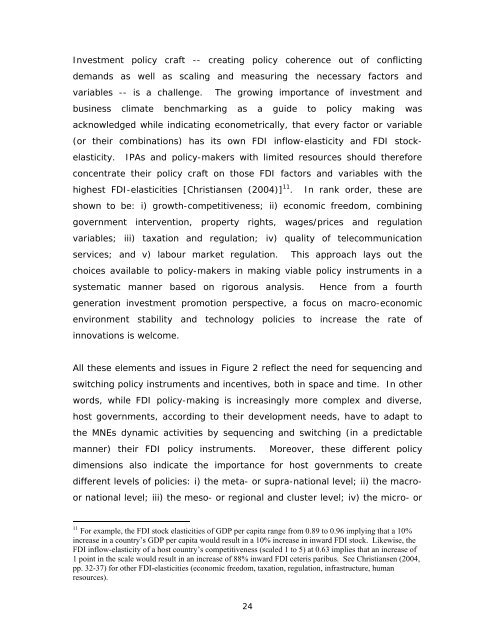(EGM) Foreign Direct Investment in Southeast Asia - Unido
(EGM) Foreign Direct Investment in Southeast Asia - Unido
(EGM) Foreign Direct Investment in Southeast Asia - Unido
Create successful ePaper yourself
Turn your PDF publications into a flip-book with our unique Google optimized e-Paper software.
<strong>Investment</strong> policy craft -- creat<strong>in</strong>g policy coherence out of conflict<strong>in</strong>g<br />
demands as well as scal<strong>in</strong>g and measur<strong>in</strong>g the necessary factors and<br />
variables -- is a challenge. The grow<strong>in</strong>g importance of <strong>in</strong>vestment and<br />
bus<strong>in</strong>ess climate benchmark<strong>in</strong>g as a guide to policy mak<strong>in</strong>g was<br />
acknowledged while <strong>in</strong>dicat<strong>in</strong>g econometrically, that every factor or variable<br />
(or their comb<strong>in</strong>ations) has its own FDI <strong>in</strong>flow-elasticity and FDI stock-<br />
elasticity. IPAs and policy-makers with limited resources should therefore<br />
concentrate their policy craft on those FDI factors and variables with the<br />
highest FDI-elasticities [Christiansen (2004)] 11 . In rank order, these are<br />
shown to be: i) growth-competitiveness; ii) economic freedom, comb<strong>in</strong><strong>in</strong>g<br />
government <strong>in</strong>tervention, property rights, wages/prices and regulation<br />
variables; iii) taxation and regulation; iv) quality of telecommunication<br />
services; and v) labour market regulation. This approach lays out the<br />
choices available to policy-makers <strong>in</strong> mak<strong>in</strong>g viable policy <strong>in</strong>struments <strong>in</strong> a<br />
systematic manner based on rigorous analysis. Hence from a fourth<br />
generation <strong>in</strong>vestment promotion perspective, a focus on macro-economic<br />
environment stability and technology policies to <strong>in</strong>crease the rate of<br />
<strong>in</strong>novations is welcome.<br />
All these elements and issues <strong>in</strong> Figure 2 reflect the need for sequenc<strong>in</strong>g and<br />
switch<strong>in</strong>g policy <strong>in</strong>struments and <strong>in</strong>centives, both <strong>in</strong> space and time. In other<br />
words, while FDI policy-mak<strong>in</strong>g is <strong>in</strong>creas<strong>in</strong>gly more complex and diverse,<br />
host governments, accord<strong>in</strong>g to their development needs, have to adapt to<br />
the MNEs dynamic activities by sequenc<strong>in</strong>g and switch<strong>in</strong>g (<strong>in</strong> a predictable<br />
manner) their FDI policy <strong>in</strong>struments. Moreover, these different policy<br />
dimensions also <strong>in</strong>dicate the importance for host governments to create<br />
different levels of policies: i) the meta- or supra-national level; ii) the macro-<br />
or national level; iii) the meso- or regional and cluster level; iv) the micro- or<br />
11 For example, the FDI stock elasticities of GDP per capita range from 0.89 to 0.96 imply<strong>in</strong>g that a 10%<br />
<strong>in</strong>crease <strong>in</strong> a country’s GDP per capita would result <strong>in</strong> a 10% <strong>in</strong>crease <strong>in</strong> <strong>in</strong>ward FDI stock. Likewise, the<br />
FDI <strong>in</strong>flow-elasticity of a host country’s competitiveness (scaled 1 to 5) at 0.63 implies that an <strong>in</strong>crease of<br />
1 po<strong>in</strong>t <strong>in</strong> the scale would result <strong>in</strong> an <strong>in</strong>crease of 88% <strong>in</strong>ward FDI ceteris paribus. See Christiansen (2004,<br />
pp. 32-37) for other FDI-elasticities (economic freedom, taxation, regulation, <strong>in</strong>frastructure, human<br />
resources).<br />
24

















